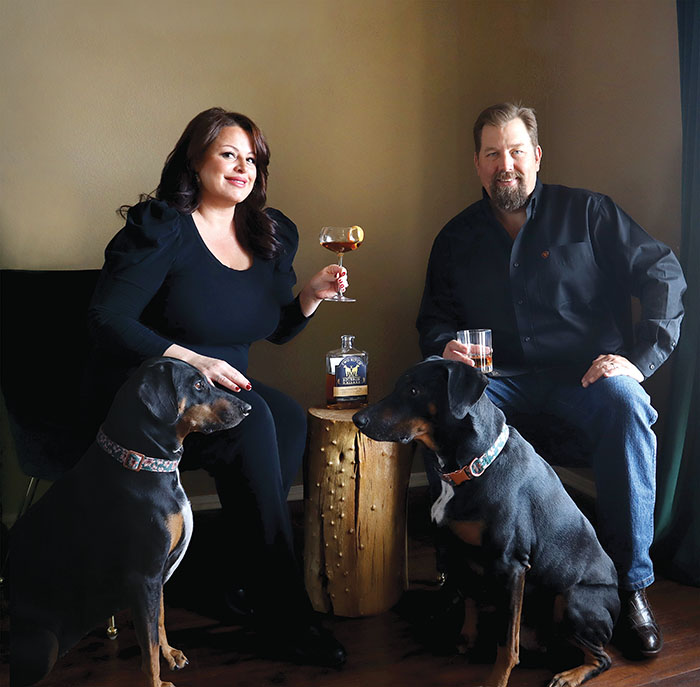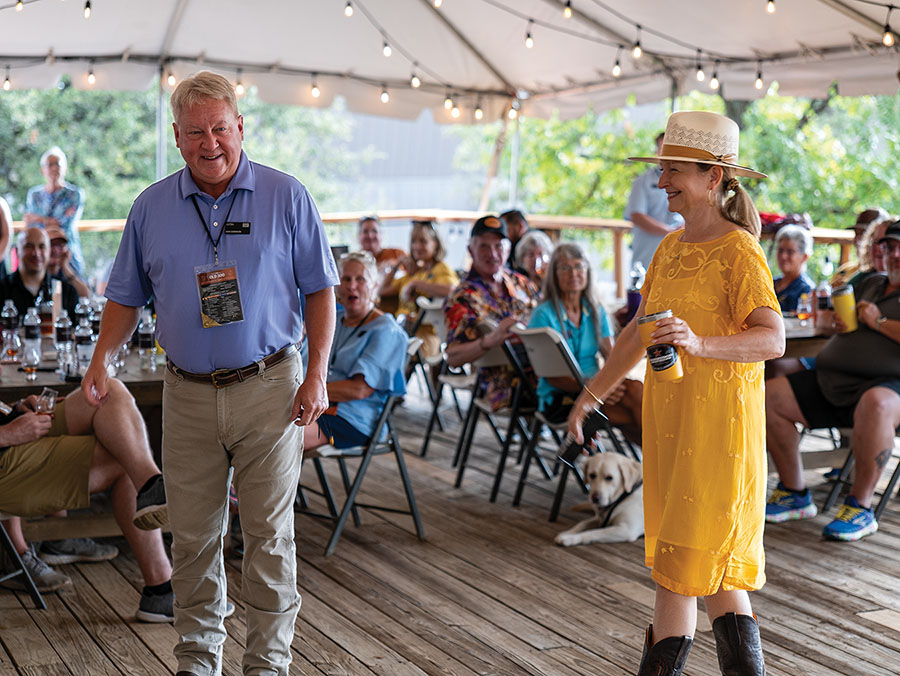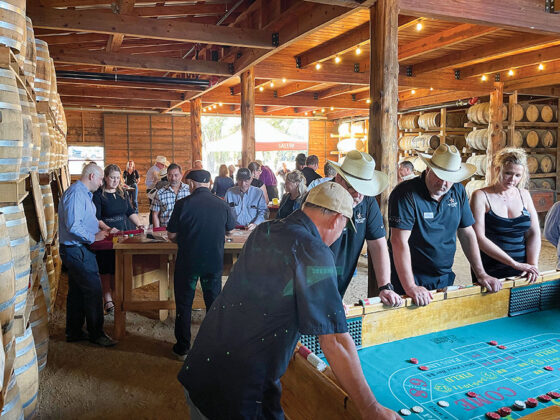Joe Luby’s wedding day was approaching. A die-hard outdoorsman, Luby and his friends were celebrating with a fishing trip in the sprawling shrublands of central Nevada. His then-fiancée, Lauren, was off enjoying a bridal shower in Albuquerque, New Mexico. On that trip through the White River Valley, he’d brought along Lauren’s chocolate Labrador-Sharpei mix, Mocha Bean. Suddenly, Mocha spotted a rabbit and bolted after it, tearing across the sand into the arid, endless country. Just like that, she’d vanished into the staggering emptiness.
Joe and his friends desperately searched for Mocha. As the hours passed, the awful gravity hit him: Mocha Bean was gone..
“He told me, ‘I’ve been dreading to make this call to you — I’m so sorry,” Lauren remembers. “So, I flew home and then drove up to where they were. I was walking around that desert, in the sagebrush, unable to find Mocha or know where she was. There was no sign of her. It’s such a vast, open area. There was just a feeling of hopelessness.”

Lauren scanned shelter web pages from Nevada to New Mexico. Mocha Bean was never seen again. However, Lauren stumbled upon a shelter’s posting about two sister puppies — a pair of floppy-eared Doberman mixes — who had been found abandoned in the desert. Mocha was lost to the desert, but these two, Scarlet and Sage, had been rescued from it.
“I didn’t even question taking just one,” Lauren recounts. “I took both of them.”
Then, she says, “Our lives just kind of spun out of control.”
They threw a whiskey party to introduce Scarlet and Sage to their circle of friends. The invitations included an elaborate mock-up of an imagined whiskey brand called Two Bitch Bourbon, named for the feisty canine sisters who had just joined their family. People were crazy for the idea, so the two delved into the world of whiskey sourcing and blending. They made their first commercial bottle a reality a year later in 2017.
Lauren and Joe’s whiskey products have since become popular across the Silver State, but the real surprise was the vibrant online community of dog lovers that grew around their brand. Propelled by user photos of bourbon bottles and dogs on Instagram, Two Bitch Bourbon has over 6,400 highly engaged canine fanatic followers across the country.
The Lubys aren’t the only distillers who have tapped the true potential of a cult following. From crowded Chicago bars where locals flex neighborhood pride with shots of a face-wincing spirit to a group of whiskey stalwarts in the hills of central Texas who’ve formed an adopted family around one tight-knit distillery, some distillers have found gold in creating community.
A Tribe of the Four-Legged
Lauren’s passion for dogs fueled their marketing and helped form their community. At the brand’s first release events, they gave away Two Bitch Bourbon dog bandanas. Customers started sending them photographs of their cute canines in the tie-on swag, and Lauren posted them on their Instagram page. Then fans started taking photos of their dogs posing with bottles of Two Bitch, which Lauren also shared. The Two Bitch Instagram was soon a pageant of eye-catching images: a black Labrador puppy trying to pry the cork out of a bottle of Eureka Gold; a giant, shaggy Saint Bernard with a bottle of Small Batch Bite positioned between his paws; a pair of Great Pyrenees pressing their wet noses on a Pack Leader Reserve vintage.
“Our tagline is ‘For the love of dogs, bourbon and good times,’ and that’s been the guiding factor for our company, which has really resonated with people,” Lauren explains. “People love dogs and we’ve always been dog people. To build something on those passions has been a no-brainer — and it’s been really easy to do.”
Running the page has proven emotional but rewarding. “The page has become kind of a photo history of the dogs,” she observes. “When a dog friend passes away, we’ll put their pictures up again to remember them. Some people will post those pics on the anniversary of their pet’s death. And you’ll see all the support from everyone. It’s just a great community that we’ve grown.” As dogged dog fanatics have propelled the brand, the Lubys have given back by donating to animal shelters and dog rescue organizations.
Only in Chicago
“It’s been said that what Fernet is to San Fran mixologist culture, [Jeppson’s] Malört is to Chicago mixologist culture,” says Tremaine Atkinson, who founded CH Distillery in Chicago in 2013. “It’s been independently owned forever, and it’s always been kind of a local thing.”
This highly unusual, somewhat controversial botanical spirit has been a fixture in Chi-Town since Prohibition. However, in recent times, Second City pride has merged with the power of the internet and some genius marketing to make Malört the gritty selection of “two-fisted drinkers.”

Malört found its way to Chicago in the early 1900s by way of a Swedish immigrant named Carl Jeppson. Hailing from Sweden’s southern farming districts, Jeppson knew a special family method of making Bäsk, a Scandinavian wormwood liquor enhanced by regional herbs and spices. During the Volstead Act, Jeppson got away with selling his extremely potent take on Malört door-to-door under the guise of it being a medicinal tonic. However, once alcohol was legal again, Jeppson didn’t feel like competing with professional producers and sold his withering recipe to D.J. Bielzoff Products Co., which, in turn, took the drink commercial. According to the The Chicago Sun-Times, Malört hung around quietly in The Windy City for decades, mostly gathering dust on “the back shelves of VFW halls and dive bars.”
Then, around 2013, Chicago bartenders started using shots of Malört as the drinking equivalent to an insider’s nod, a secret handshake, or some kind of terrible blood oath — and with a boost from social media, Malört became a cult hit.
Ironically, even as Malört was becoming a symbol of that city’s bar scene, it was no longer being produced there. The last distillery in Chicago had closed in the 1980s, and George Brode, the attorney who ended up owning the Jeppson Malört Company, was ultimately forced to move its production to Florida. Brode’s secretary, Patricia Gabelick, would later inherit the rights to Malört after his passing.
When Atkinson, the head distiller and CEO of the largest craft distillery in Chicago, heard that Gabelick was contemplating bowing out of the Malört game, he sprang into action.
“Five years of me bugging her finally led to her deciding she wanted to retire and sell the company to us,” Atkinson recalls. “When that happened, we brought the production home. It’s one of the few liquor products that’s directly associated with a city. And for years it was only available here in Illinois. When I announced that we were doing this deal, I told everyone at the company, ‘Let’s just not mess this up. It doesn’t need us to make it slick — or make it stupid.’”
CH Distillery decided to keep its Malört the same Malört that everybody’s always known — for better or worse. In the era of the internet, people’s first-time reactions to a taste had already taken on a life of their own. Between YouTube videos, Facebook reels, and Instagram stories, the digital space had become cluttered with comments about first encounters with Malört:
“Smells like formaldehyde.”
“Smells like a wet dog.”
“Smells like stagnant pond water near Chernobyl.”
“It tastes like a copper pipe.”
“It’s like I just sprayed hair spray in my mouth.”
“It’s cantaloupe plus tires.”
“It’s like being picked on in the fifth grade.”
“I’m going to cut my tongue off a little bit.”
People love posting pics of their “Malört face,” the expression they make after the true weight of the “sweetest Swedish liquor” settles on their tongue. Think bent mouths, watery eyes, sucked in cheeks, and a slow gasping for breath after the throat clears.
CH Distillery shares all this flavor backlash to Malört on its own social media. The result is a growing public fascination that’s spilled over into pop culture. The Hulu series The Bear, which is set in the Chicago culinary scene, featured a huge billboard of Malört in one of its sequences.
“Sometimes people will see that I’m wearing a Malört t-shirt and they’ll say, ‘Oh wow, you like that stuff?’ And I’ll just respond, ‘I like it so much I bought the company,’” the distiller notes. “That’s when I’ll hear things like, ‘Oh, I’ve got to tell you about the first time I had Malört.’ Or, ‘My dad introduced me to that.’ Or, ‘I was out with my buddies and they bought me a shot and I was like, ‘What the hell was that?’ They all have a story — and that’s why it has endurance. People associate it with moments in their lives.”
He adds, “I don’t know that Malört would have taken root in another city. New York or Boston, yeah, those are tough cities too; but here there’s a certain attitude that’s like, ‘These winters are so brutal, but what, am I going to move to Arizona? That’s bullshit — give me a shot of Malört.’ That’s kind of a dream, you know. But it does require a light touch on our part. We kind of let the fans rule the madhouse.”
The Spartans of Texas

Dan and Nancy Garrison were laying out a spread in the middle of a torrential downpour. The couple’s “head marketing dude,” Rob Cordes, had just gotten back from fly fishing in Alaska and was wearing his rain gear from The Last Frontier as he held an umbrella over the cooking fire.
“I was trying to make sure the flame wouldn’t go out so we could eat,” Cordes says, looking back. “It was just a crazy storm.”
The trio from Garrison Brothers Distillery was struggling to pull off the inaugural event for a new club they were starting. Fervent fans of Garrison’s could pay $2,000 to join The Old 300, a group that would have access to exclusive bourbon camps on the distillery’s ranch that included food, dancing, music, bottling, and skeet shooting, not to mention hunting on the property. Members would also get to pick and sign certain barrels and have special purchasing rights for bottles from those barrels.
Cordes himself believed in the club so much that he officially became Old 300 Member No.1. He believed in it enough to fight the fiercest elements in a gambit to rescue its first barbecue. Ultimately, some 15 club members emerged through the gale.
The Garrisons and Cordes weren’t sure if the concept really had legs.
The next year when they put on an event for The Old 300, there was no typhoon, and more than 75 people came. The following year, it had 100 members.
Today, The Old 300 consists of 300 families who have made Garrison Brothers an ongoing part of their lives. Its members don’t just enjoy those bourbon camps; they also come to spring carnivals at the distillery, show up at hand-bottling events, help drive charity fundraisers, and generally hang out at the distillery’s bar and restaurant. Beyond all that, they’re semi-official brand ambassadors who are spreading the gospel of grain-to-glass dreams in the Lone Star State.
“They proudly started creating their own Old 300 coins and clothing and stuff that we never even thought of,” Cordes explains. “They took it to that next level.”
And they also took bottles of Garrison Brothers into their favorite drinking and dining spots all across Texas.
“Back when we started it, we were so small and rubbing nickels together, and we needed friends,” Nancy says. “We needed people to go out and talk about Garrison Brothers. Now, their passion for our bourbon has opened doors for us, and we love that.”
That passion has even gone a little too far into overdrive at times, in the sense that some Old 300 members have been quite assertive when talking to establishment owners who aren’t carrying their favorite whiskey. The Garrisons and Cordes have had to coach members on the most appropriate ways to have those conversations. But, for a distillery team, it’s a good problem to have.
For Dan, that loyalty especially paid off when Anthony Bourdain was filming an episode of his Travel Channel TV show No Reservations in Austin, Texas, at a famous barbecue joint on South First Street. A member of The Old 300 happened upon the scene. While Bourdain was talking to one of the city’s grill masters on camera, the club member dropped a bottle of Garrison Brothers in front of him.
“Bourdain turns to the camera and says, ‘Oh, I’ve heard about this stuff,’’ Dan recalls, “and he takes a swig of it and he passes it to the famous barbecue chef.”
While moments like that are a highlight, for Nancy it is the broader trend of Old 300 members choosing to spend time with each other and keep in touch with each other outside of the distillery’s activities that make it so special.
“It’s really not accurate to call it a club,” she says, “it is more of a family.”
Dan was hours away from hosting a live Zoom call with Old 300 members only.
“We’re going to open that with a prayer, because we just found out that one of our members has pretty bad cancer,” Dan reflects. “And that will be part of the discussion tonight. And I’m sure there will be some teary eyes.” It’s a perfect example of how the Old 300 — much like Two Bitch and Malört — has created a culture around spirits that goes well beyond a simple drink.












